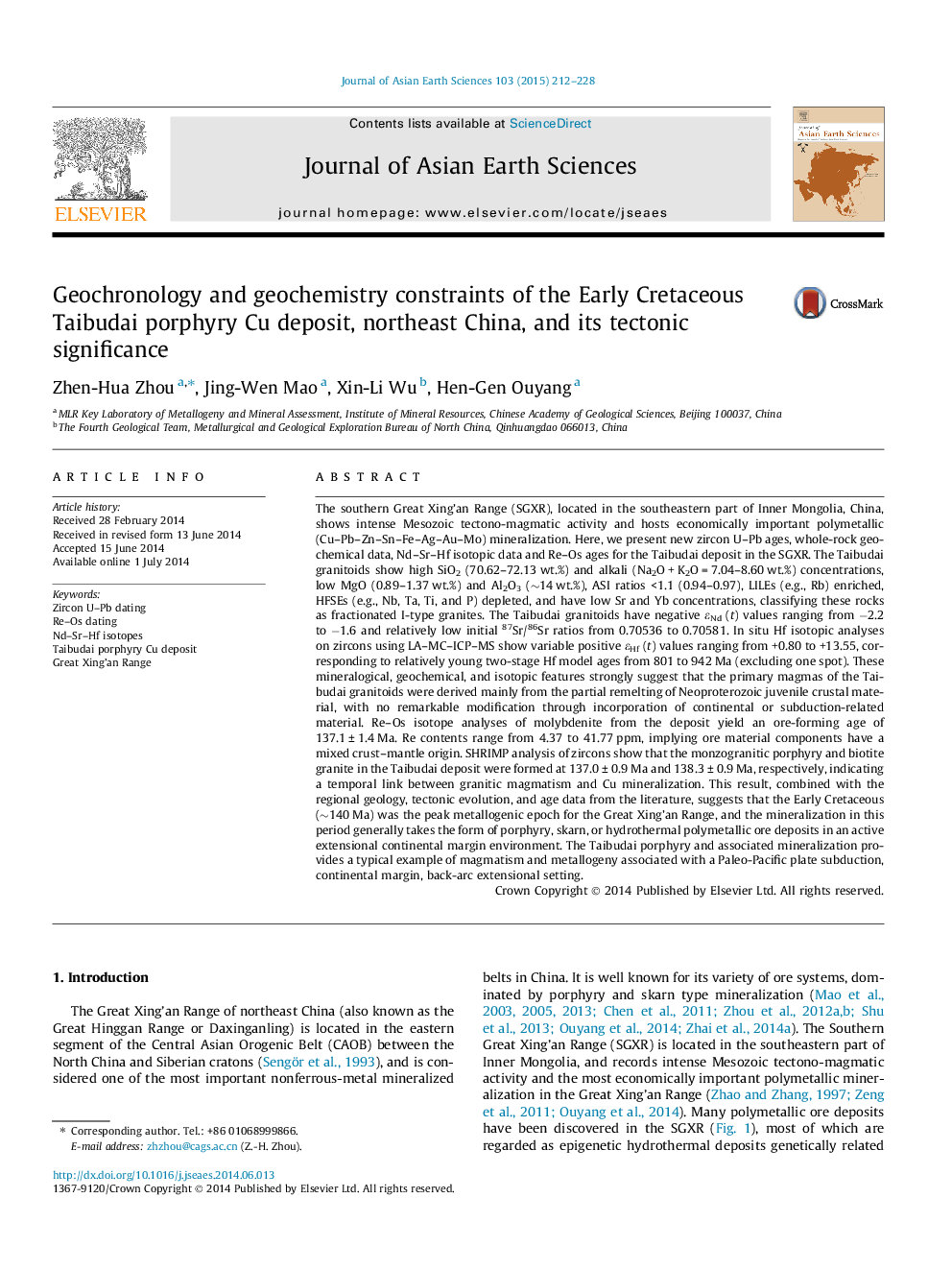| کد مقاله | کد نشریه | سال انتشار | مقاله انگلیسی | نسخه تمام متن |
|---|---|---|---|---|
| 4730359 | 1640366 | 2015 | 17 صفحه PDF | دانلود رایگان |
• Geochronology study show Tabudai the youngest porphyry Cu deposit in NE China so far.
• Intrusions originated from the partial remelting of the juvenile crustal material.
• The tectonic setting linked to the continental margin back-arc extension environment.
The southern Great Xing’an Range (SGXR), located in the southeastern part of Inner Mongolia, China, shows intense Mesozoic tectono-magmatic activity and hosts economically important polymetallic (Cu–Pb–Zn–Sn–Fe–Ag–Au–Mo) mineralization. Here, we present new zircon U–Pb ages, whole-rock geochemical data, Nd–Sr–Hf isotopic data and Re–Os ages for the Taibudai deposit in the SGXR. The Taibudai granitoids show high SiO2 (70.62–72.13 wt.%) and alkali (Na2O + K2O = 7.04–8.60 wt.%) concentrations, low MgO (0.89–1.37 wt.%) and Al2O3 (∼14 wt.%), ASI ratios <1.1 (0.94–0.97), LILEs (e.g., Rb) enriched, HFSEs (e.g., Nb, Ta, Ti, and P) depleted, and have low Sr and Yb concentrations, classifying these rocks as fractionated I-type granites. The Taibudai granitoids have negative εNd (t) values ranging from −2.2 to −1.6 and relatively low initial 87Sr/86Sr ratios from 0.70536 to 0.70581. In situ Hf isotopic analyses on zircons using LA–MC–ICP–MS show variable positive εHf (t) values ranging from +0.80 to +13.55, corresponding to relatively young two-stage Hf model ages from 801 to 942 Ma (excluding one spot). These mineralogical, geochemical, and isotopic features strongly suggest that the primary magmas of the Taibudai granitoids were derived mainly from the partial remelting of Neoproterozoic juvenile crustal material, with no remarkable modification through incorporation of continental or subduction-related material. Re–Os isotope analyses of molybdenite from the deposit yield an ore-forming age of 137.1 ± 1.4 Ma. Re contents range from 4.37 to 41.77 ppm, implying ore material components have a mixed crust–mantle origin. SHRIMP analysis of zircons show that the monzogranitic porphyry and biotite granite in the Taibudai deposit were formed at 137.0 ± 0.9 Ma and 138.3 ± 0.9 Ma, respectively, indicating a temporal link between granitic magmatism and Cu mineralization. This result, combined with the regional geology, tectonic evolution, and age data from the literature, suggests that the Early Cretaceous (∼140 Ma) was the peak metallogenic epoch for the Great Xing’an Range, and the mineralization in this period generally takes the form of porphyry, skarn, or hydrothermal polymetallic ore deposits in an active extensional continental margin environment. The Taibudai porphyry and associated mineralization provides a typical example of magmatism and metallogeny associated with a Paleo-Pacific plate subduction, continental margin, back-arc extensional setting.
Journal: Journal of Asian Earth Sciences - Volume 103, 1 May 2015, Pages 212–228
